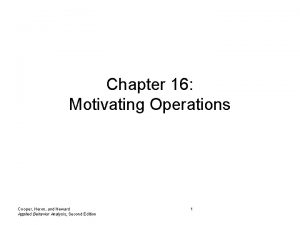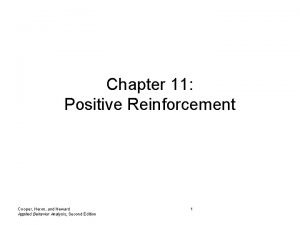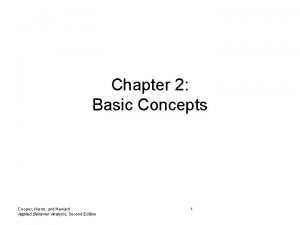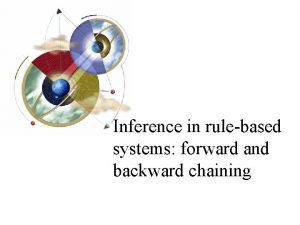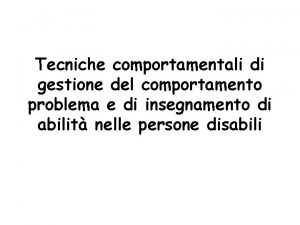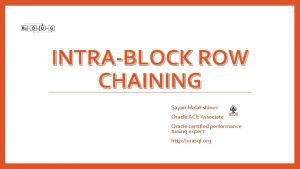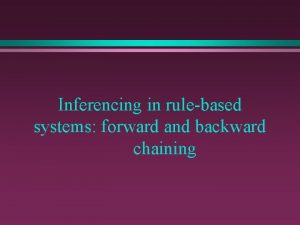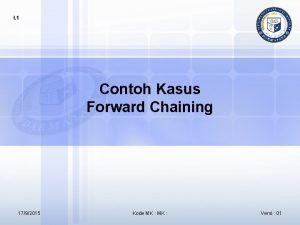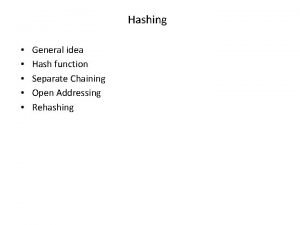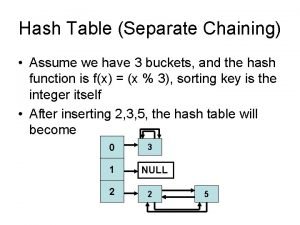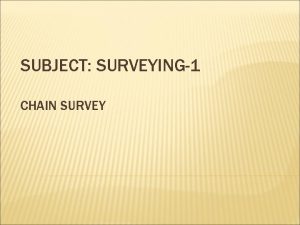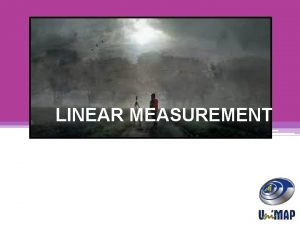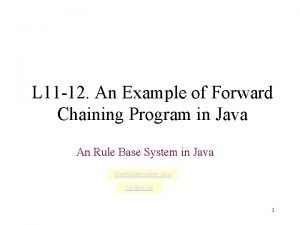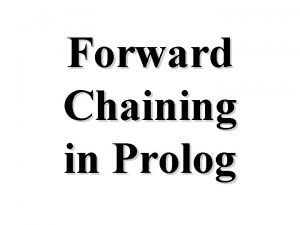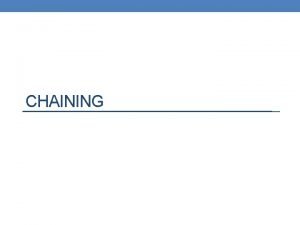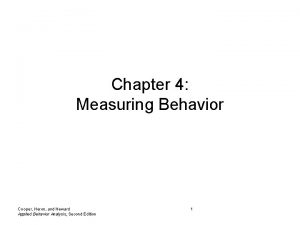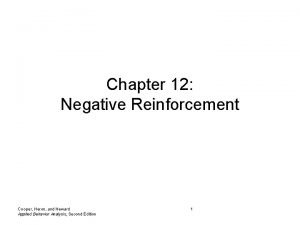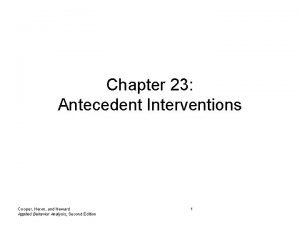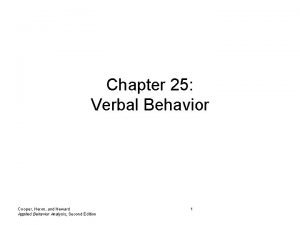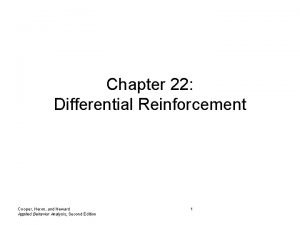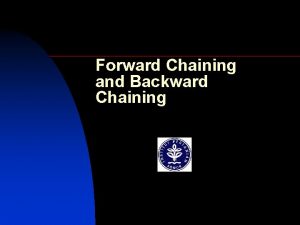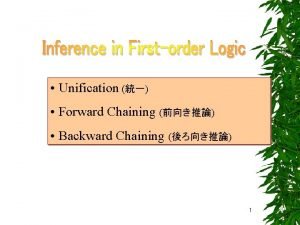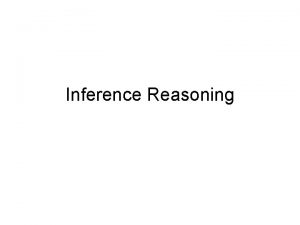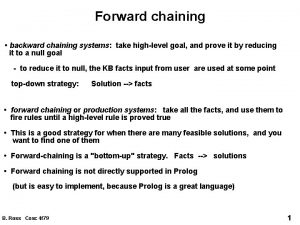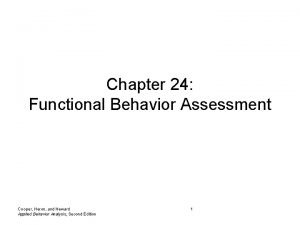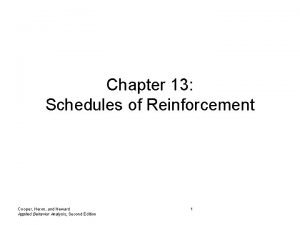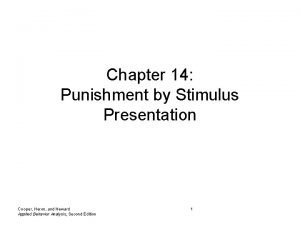Chapter 20 Chaining Cooper Heron and Heward Applied



























- Slides: 27

Chapter 20: Chaining Cooper, Heron, and Heward Applied Behavior Analysis, Second Edition 1

Definition of a Behavior Chain • A specific sequence of discrete responses • Each associated with a particular stimulus condition • When components are linked together, they form a chain that produces a terminal outcome Cooper, Heron, and Heward Applied Behavior Analysis, Second Edition 2

Components in Chain Serve Dual Functions • Each response in the chain serves as a conditioned reinforcer for the response that produced it • Each response in the chain serves as a discriminative stimulus for the next response in the chain • (Exceptions: the first and last responses in the chain) Cooper, Heron, and Heward Applied Behavior Analysis, Second Edition 3

Diagram of Response Chain EO SD Absence of food for 2 hours Mom says “Fix yourself a bowl of cereal. ” SD SD Response 1 Get cereal from cupboard SD Response 4 Response 5 Get spoon from drawer Pour cereal SR+ into bowl SR+ SD Response 9 SD SD Response 2 S Get milk from R+refrigerator SD SD Response 6 Response 7 Pour milk SR+into bowl Put milk SR+ away Response 3 S Get bowl from R+cupboard SD Response 8 Put cereal SR+ away SD Response 10 Take bowl Sit down at and spoon to table Cooper, Heron, and Heward R+ table SR+Behavior Applied Analysis, Second. SEdition Response 11 Eat SR+ 4 SR+ Food Presented Fixing a bowl of cereal more likely when hungry and told to “Fix yourself a bowl of cereal”

Behavior Chains and Limited Hold • A sequence of behaviors that must be performed correctly and within a specified time to produce reinforcement • Emphasizes both accuracy and proficiency Cooper, Heron, and Heward Applied Behavior Analysis, Second Edition 5

Characteristics of Behavior Chains • A series of discrete responses • Performance of behavior changes the environment such that it produces conditioned reinforcement for previous response and serves as SD for next response • Behaviors must occur in sequence and in close temporal succession Cooper, Heron, and Heward Applied Behavior Analysis, Second Edition 6

Rationale for Chaining • Teaches complex skills that allow individuals to function more independently • A way to add new behaviors to an existing behavioral repertoire • Can easily be combined with other procedures (prompting, instructions, reinforcement) Cooper, Heron, and Heward Applied Behavior Analysis, Second Edition 7

Task Analysis • Breaking a complex skill or series of behaviors into smaller, teachble units • The product of a task analysis is a series of sequentially ordered steps Cooper, Heron, and Heward Applied Behavior Analysis, Second Edition 8

Constructing a Task Analysis • Notes: – Sequence one individual may use to perform skill may not be the same as another individual – Must be individualized according to • • Age Skill level Disability Prior experience – Some task analyses have a limited number of steps, but these steps may be broken down into subtasks Cooper, Heron, and Heward Applied Behavior Analysis, Second Edition 9

Constructing a Task Analysis • Methods – Observe a competent individual perform the task – Consult with experts or persons skilled in performing the task – Perform the task yourself • Can refine it as you use it, if necessary Cooper, Heron, and Heward Applied Behavior Analysis, Second Edition 10

Assessing Mastery Levels • Single-opportunity Method – Give cue to begin task – Record learner performance with + or - for each step – Assessment stops as soon as a step is performed incorrectly – Remaining steps are scored with a - Cooper, Heron, and Heward Applied Behavior Analysis, Second Edition 11

Assessing Mastery Levels • Multiple-opportunity Method – Give cue to begin task – Record learner performance with + or - for each step – If a step is performed incorrectly, the trainer completes that step for the learner – learner continues to next step – Do NOT co-mingle teaching with assessment Cooper, Heron, and Heward Applied Behavior Analysis, Second Edition 12

Single vs. Multiple Method? • Single-opportunity Method – – More conservative Gives less information Quicker to conduct Reduces likelihood of learning taking place during assessment • Multiple – Takes more time to complete – Provides trainer with more information – May make training more efficient by allowing trainer to eliminate instruction on already-learned steps Cooper, Heron, and Heward Applied Behavior Analysis, Second Edition 13

Behavior Chaining Procedures • Forward Chaining – Training begins the link with the first behavior in the sequence – Training only occurs on the steps previously mastered and current step (no training on steps after that) • Advantages – Can be used to link smaller chains to larger ones – Relatively easy Cooper, Heron, and Heward Applied Behavior Analysis, Second Edition 14

Behavior Chaining Procedures • Total-task Chaining – Training is provided for every behavior in the sequence during every training session – Trainer assistance (prompting) is provided on every step Cooper, Heron, and Heward Applied Behavior Analysis, Second Edition 15

Behavior Chaining Procedures • Backward Chaining – Training begins the link with the last behavior in the sequence – Trainer performs all by last step until learner masters last step – Then trainer performs all but last two steps until learner masters last two steps, and so on… • Advantages – Natural reinforcement is produced immediately upon the learner’s response – Learner contacts these natural contingencies of reinforcement on every learning trial Cooper, Heron, and Heward Applied Behavior Analysis, Second Edition 16

Behavior Chaining Procedures • Backward Chaining with Leap Aheads – Follows same procedures as backward chaining, but not every step in the task analysis is trained – Other steps are probed – If some steps are in learner’s repertoire, they are not taught – The learner is still required to perform those steps, however Cooper, Heron, and Heward Applied Behavior Analysis, Second Edition 17

Which procedure to use? • No data to indicate one is more effective than another • Choose total-task chaining if – Learner knows many of the tasks but needs to learn how to do them in sequence – Has an imitative repertoire – Has moderate to severe disabilities – Task is not long or complex Cooper, Heron, and Heward Applied Behavior Analysis, Second Edition 18

Behavior Chain Interruption Strategy (BCIS) • Chain is interrupted at a predetermined step so that another behavior can be emitted • Interruption may cause some distress – It momentarily blocks access to reinforcement • This is somewhat desirable because it creates motivation to learn the new behavior in the chain – As long as it is not so distressful that it causes emotional responding or self-injurious behavior Cooper, Heron, and Heward Applied Behavior Analysis, Second Edition 19

Behavior Chain Interruptioin Strategy (BCIS) • Collect baseline data • Direct person to start chain • At predetermined point, restrict learner’s ability to complete next step • Prompt learner to engage in new targeted step • Then allow the individual to proceed with the chain Cooper, Heron, and Heward Applied Behavior Analysis, Second Edition 20

Breaking Inappropriate Chains • Determine initial SD and – Substitute an alternative, or – Extend chain and build in time delays within the chain • Examine potential sources of difficulty in the chain Cooper, Heron, and Heward Applied Behavior Analysis, Second Edition 21

Breaking Inappropriate Chains • Examining potential sources of difficulty – Re-examine SDs and responses • Is sequence arbitrary? Would rearranging sequence help? – Determine whether similar SDs cue different responses • If so, can the sequence be rearranged to separate the two similar SDs? Cooper, Heron, and Heward Applied Behavior Analysis, Second Edition 22

Breaking Inappropriate Chains • Examining potential sources of difficulty – Analyze the job setting to identify relevant and irrelevant SDs • Do you need to implement discrimination training so that the learner can discriminate the relevant from irrelevant SDs? – Determine whether SDs in the job setting differ from training SDs • May need to conduct some training in job setting Cooper, Heron, and Heward Applied Behavior Analysis, Second Edition 23

Breaking Inappropriate Chains • Examining potential sources of difficulty – Identify presence of novel stimuli in the environment • Discrimination training might be necessary to teach the learner to ignore novel, irrelevant stimuli Cooper, Heron, and Heward Applied Behavior Analysis, Second Edition 24

Factors Affecting Performance • Completeness of the task analysis – More complete, detailed task analyses tend to produce better learning • Time developing task analyses is well spent • Be ready/willing to modify it after it is constructed • Length/complexity of chain – Longer chains take more time to learn Cooper, Heron, and Heward Applied Behavior Analysis, Second Edition 25

Factors Affecting Performance • Schedule of reinforcement – Must use appropriate schedule (Ch. 13) – Consider number of responses in chain when determining the schedule • Extinction – Responses performed further from the reinforcer may become less likely – This interrupts the SD relation and can result in withering performance of the chain – Lesson: adjust reinforcement schedule accordingly (use intermittent schedules) Cooper, Heron, and Heward Applied Behavior Analysis, Second Edition 26

Factors Affecting Performance • Stimulus variation – Introduce all variations of the stimulus items to be encountered later to increase generalization of the chain • Response variation – Varied responses may be needed to deal with stimulus variation – This may require some retraining of responses Cooper, Heron, and Heward Applied Behavior Analysis, Second Edition 27
 Motivating operation
Motivating operation Circular reasoning aba
Circular reasoning aba Shaping within topography example
Shaping within topography example Cooper
Cooper Forward chaining and backward chaining example
Forward chaining and backward chaining example Backward
Backward Prompting fading shaping modeling chaining
Prompting fading shaping modeling chaining Backward chaining occupational therapy
Backward chaining occupational therapy Service chaining use cases
Service chaining use cases Full form of jess in expert system technology
Full form of jess in expert system technology Row chaining oracle
Row chaining oracle Backward chaining
Backward chaining Contoh kasus backward chaining
Contoh kasus backward chaining Quadratic probing
Quadratic probing 03123456
03123456 Contoh rule base sistem pakar
Contoh rule base sistem pakar Concatenamento retrogrado
Concatenamento retrogrado Chaining procedures aba
Chaining procedures aba Contoh generalisasi stimulus
Contoh generalisasi stimulus Cipher-block chaining
Cipher-block chaining Indian optical square in surveying
Indian optical square in surveying Servlet chaining
Servlet chaining Contoh soal forward chaining dan penyelesaiannya
Contoh soal forward chaining dan penyelesaiannya Hypotenusal allowance equation
Hypotenusal allowance equation Forward chaining examples
Forward chaining examples Forward chaining
Forward chaining Behavior chain with limited hold
Behavior chain with limited hold Forward chaining
Forward chaining
